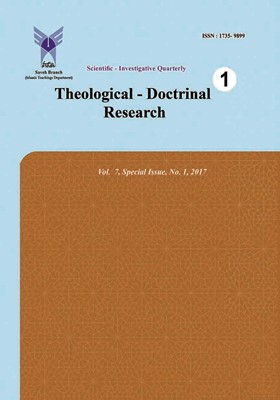Religious education in the curriculum of religion and life Second high school in the viewpoint of the experts
Subject Areas : کلام اسلامی
Keywords: verbal education, cognitive components, cardiac and emotional acceptance (love and affection),
Abstract :
This article was written by the experts in the view of the experts in the field of religious education in the curriculum of religion and life. The field research method has been conducted through a survey method through an interview with the experts. The statistical community has been formed by scholarly experts in religious affirmation of students. The sample size is 80 people based on Morgan's sampling table. Random sampling method and data analysis method are a combination of quantitative and qualitative techniques. The text of the conversations with the experts has been examined through content analysis, the data unit required for extraction and their variety have been recorded in abundance. In addition, descriptive statistics indices have been used to analyze the data. The findings indicate that the cognitive components of religious education in terms of experts are: the characteristics of the Creator of Being, Prophecy and Prophet, God's righteousness, Resurrection and the Day of Resurrection. The components of the acceptance of the heart in the cultivation of belief are: the faithfulness of God and his attributes, the heart's belief in the Prophetic prophecy, the belief in the principle of Imamate, the belief in divine justice, and the Day of Resurrection. From the point of view of the experts, the components of emotional or affection and interest in religious education are: The interest of the learners in being the Creator, faith with love for the mission and the soul of the prophethood, the interest in the province and the Imams undefiled, the deepened belief in God's justice. Positive attitude and interest in Doomsday. The findings show that if the content of religious books and the teaching methods of teachers in religious education are given sufficient attention to the order and sequence of the components, then optimal belief education It turns out.
اعظمی،بهارک؛ موسی پور، نعمت اله؛ باقری؛ خسرو؛ عسگری، محمد علی. (1395). گونه شناسی تجارب دینی دانش آموختگان دبیرستانی و میزان انطباق آن با اهداف اعتقادی نظام آموزشی ایران. فصل نامه مطالعات برنامه درسی (33)، صص 32-15.
جوادي آملي، عبدالله. (1386). اسرار عبادات. تهران: نشر الزهرا.
داودي، محمد. (1386). تربيت ديني (جلد 2). قم: پژوهشگاه حوزه و دانشگاه.
. (1388). تأمل در هدف تربيت اعتقادي. دو فصل نامه علمي – پژوهشي. (9). 61-47.
سبحاني نژاد، مهدي. (1394). تحليل محتواي کتابهاي دين و زندگي دوره متوسطه از لحاظ سبک زندگي اسلامي. فصل نامه انديشه هاي نوين تربيتي. (1). 32-25.
شجاعي زند، عليرضا. (1388). تبارشناسي «تجربه ديني» در مطالعات دين داري. فصل نامه تحقيقات فرهنگي. (6). 47-31.
شمشيري، بابک. (1392). تحليل محتواي کتابهاي دين و زندگي دوره متوسطه با تأکيد بر مؤلفه هاي وحدت اسلامي. دو فصل نامه علمي پژوهشي تربيت اسلامي. (17). 28-7.
صادقي لويه، ناهيد. (1392). تحليل محتواي کتاب درسي دين و زندگي پايه دوم متوسطه از ديدگاه معلمان. پايان نامه کارشناسي ارشد. رودهن: دانشگاه آزاد اسلامي.
صانعي، مهدي. (1382). بهداشت روان در اسلام. قم: بوستان کتاب.
فرهاديان، رضا. (1372). اصول و مباني تعليم و تربيت در قرآن. قم: انتشارات دارالهادي.
ملکي، حسن. (1382). مباني و اصول تربيت. زنجان: انتشارات نيکان کتاب.
ميرعرب. فرج اله. (1392). تربيت اعتقادي و معنوي با نگاه قرآني. قم: نشر بوستان.
نجاتي، محمدعثمان. (1367). قرآن و روانشناسي. ترجمه عباس عرب. مشهد: بنياد پژوهشهاي اسلامي.
نجفي، حسن. (1393). تحليل محتواي بعد اخلاقي اهداف مصوب در کتاب هاي درسي دوره متوسطه ايران. فصل نامه معرفت اخلاقي. (15). 28-20.
نوروزي، رضاعلي؛ صيادي شهرکي، سميه؛ مرادي، محمدرضا. (1392). ميزان پاسخگويي محتواي برنامه درسي دين و زندگي دوره متوسطه به نيازهاي اجتماعي و عاطفي دانش آموزان. نشريه پژوهش در برنامه ريزي درسي. (پياپي 37). 154-136.
هاشمي، طاهره. (1390). نقد و بررسي محتواي کتابهاي دين و زندگي دوره دبيرستان. طرح پژوهشي. مياندوآب: اداره آموزش و پرورش.
Karamouz is Polikapos. (2015). The Greek Religion Innovation.
Kathleen, H; Corriveau, Eva; Chen, E; Harris.L (2013).Judgments About fact and Fiction by Children from Religious Nonreligious Backgrounds.
Lippman, Laura. H and Hugh Mcintosh. (2010). The Demographics of Spirituality and Religiosity Among Youth: International and U.S. Patterns.
Nethanel, Toobin. (2006). The Attitude to the other and to Peace in Iranian School and Teachers Guudes downlo Center for Monitoring the Impact of Peace, Study Downloadable From: http://www.edume.org.
SATC. (2007). Iranian Texbooks: Content and Context, Research Report, www.Fas.org.

